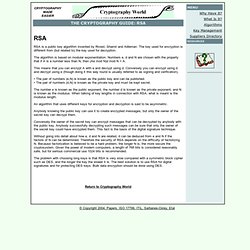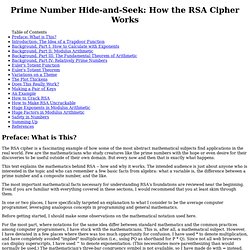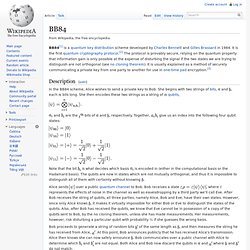

Cryptographic Algorithms : RSA. RSA is a public key algorithm invented by Rivest, Shamir and Adleman.

The key used for encryption is different from (but related to) the key used for decryption. The algorithm is based on modular exponentiation. Numbers e, d and N are chosen with the property that if A is a number less than N, then (Ae mod N)d mod N = A. This means that you can encrypt A with e and decrypt using d. Conversely you can encrypt using d and decrypt using e (though doing it this way round is usually referred to as signing and verification). • The pair of numbers (e,N) is known as the public key and can be published. • The pair of numbers (d,N) is known as the private key and must be kept secret.
Cryptographic Algorithms : RSA. Papers.nips.cc/paper/4858-adaptive-anonymity-via-b-matching.pdf. A implementation of RSA public key encryption algorithms in python, make some minor changes to cure some boredom.. Euler's totient function. Prime Number Hide-and-Seek: How the RSA Cipher Works. Preface: What is This?

The RSA cipher is a fascinating example of how some of the most abstract mathematical subjects find applications in the real world. Few are the mathematicians who study creatures like the prime numbers with the hope or even desire for their discoveries to be useful outside of their own domain. But every now and then that is exactly what happens. This text explains the mathematics behind RSA -- how and why it works. The intended audience is just about anyone who is interested in the topic and who can remember a few basic facts from algebra: what a variable is, the difference between a prime number and a composite number, and the like.
The most important mathematical facts necessary for understanding RSA's foundations are reviewed near the beginning. In one or two places, I have specifically targeted an explanation to what I consider to be the average computer programmer, leveraging analogous concepts in programming and general mathematics. NSA-GCHQ Snowden leaks: A glossary of the key terms. 28 January 2014Last updated at 14:06 ET By Leo Kelion Technology reporter The documents leaked by Edward Snowden have led the White House to call for reforms When the Guardian and Washington Post newspapers published the first of Edward Snowden's NSA-GCHQ leaks in June, it unleashed a stream of abbreviations, acronyms and jargon describing the cyberspies' activities.

Below are some of the key terms referred to in the classified documents and the reports about them. The list refers to documents alleged to have been sourced by Snowden from various intelligence agencies that have been printed by other news outlets. Where possible there are links to the original articles and the documents they refer to. The name given to an open-source database created by the National Security Agency (NSA) but later made available to others via the Apache Foundation. One of its key features is that users with different levels of clearance are shown different amounts of information. Their codenames included: RSA - Information Security, Governance, Risk, and Compliance. Www.csee.umbc.edu/~lomonaco/ams/lecturenotes/SamGrover.pdf. BB84. Description[edit] In the BB84 scheme, Alice wishes to send a private key to Bob.

She begins with two strings of bits, and , each bits long. Qubits, are the bits of , respectively. Give us an index into the following four qubit states: Note that the bit is what decides which basis is encoded in (either in the computational basis or the Hadamard basis). Alice sends over a public quantum channel to Bob. . , where represents the effects of noise in the channel as well as eavesdropping by a third party we'll call Eve. . , it makes it virtually impossible for either Bob or Eve to distinguish the states of the qubits.
Bob proceeds to generate a string of random bits of the same length as , and then measures the string he has received from Alice, The BB84 Protocol. Www.cs.ut.ee/~unruh/qc11/notes.pdf. 143.132.8.23/cms/tues/docs/Cryptography/Module-PublicKeyEncryption-RSA.pdf.